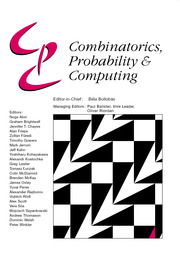Crossref Citations
This article has been cited by the following publications. This list is generated based on data provided by
Crossref.
Flier, Holger
Mihalák, Matúš
Widmayer, Peter
and
Zych, Anna
2011.
Graph-Theoretic Concepts in Computer Science.
Vol. 6986,
Issue. ,
p.
155.
Har-Peled, Sariel
2014.
Quasi-Polynomial Time Approximation Scheme for Sparse Subsets of Polygons.
p.
120.
Matoušek, Jiří
2014.
Geometry, Structure and Randomness in Combinatorics.
p.
61.
FOX, JACOB
and
PACH, JÁNOS
2014.
Applications of a New Separator Theorem for String Graphs.
Combinatorics, Probability and Computing,
Vol. 23,
Issue. 1,
p.
66.
Ackerman, Eyal
Fox, Jacob
Pach, János
and
Suk, Andrew
2014.
On grids in topological graphs.
Computational Geometry,
Vol. 47,
Issue. 7,
p.
710.
Rok, Alexandre
and
Walczak, Bartosz
2014.
Outerstring graphs are χ-bounded.
p.
136.
MATOUŠEK, JIŘÍ
2014.
Near-Optimal Separators in String Graphs.
Combinatorics, Probability and Computing,
Vol. 23,
Issue. 1,
p.
135.
Lasoń, Michał
Micek, Piotr
Pawlik, Arkadiusz
and
Walczak, Bartosz
2014.
Coloring Intersection Graphs of Arc-Connected Sets in the Plane.
Discrete & Computational Geometry,
Vol. 52,
Issue. 2,
p.
399.
Flier, Holger
Mihalák, Matúš
Widmayer, Peter
Zych, Anna
Kobayashi, Yusuke
and
Schöbel, Anita
2015.
Selecting vertex disjoint paths in plane graphs.
Networks,
Vol. 66,
Issue. 2,
p.
136.
Mustafa, Nabil H.
and
Pach, János
2015.
Graph Drawing and Network Visualization.
Vol. 9411,
Issue. ,
p.
207.
Nešetřil, Jaroslav
and
Ossona de Mendez, Patrice
2015.
A Note on Circular Chromatic Number of Graphs with Large Girth and Similar Problems.
Journal of Graph Theory,
Vol. 80,
Issue. 4,
p.
268.
PACH, JÁNOS
and
WALCZAK, BARTOSZ
2016.
Decomposition of Multiple Packings with Subquadratic Union Complexity.
Combinatorics, Probability and Computing,
Vol. 25,
Issue. 1,
p.
145.
Mustafa, Nabil H.
and
Pach, János
2016.
On the Zarankiewicz problem for intersection hypergraphs.
Journal of Combinatorial Theory, Series A,
Vol. 141,
Issue. ,
p.
1.
Conlon, David
Fox, Jacob
Lee, Choongbum
and
Sudakov, Benny
2016.
Ramsey numbers of cubes versus cliques.
Combinatorica,
Vol. 36,
Issue. 1,
p.
37.
Pach, János
and
Tóth, Géza
2018.
Graph Drawing and Network Visualization.
Vol. 10692,
Issue. ,
p.
153.
Do, Thao T.
2018.
Zarankiewicz's problem for semi-algebraic hypergraphs.
Journal of Combinatorial Theory, Series A,
Vol. 158,
Issue. ,
p.
621.
Dujmović, Vida
Joret, Gwenaël
Morin, Pat
Norin, Sergey
and
Wood, David R.
2018.
Orthogonal Tree Decompositions of Graphs.
SIAM Journal on Discrete Mathematics,
Vol. 32,
Issue. 2,
p.
839.
Pach, János
Rubin, Natan
and
Tardos, Gábor
2018.
A Crossing Lemma for Jordan curves.
Advances in Mathematics,
Vol. 331,
Issue. ,
p.
908.
Pach, János
Rubin, Natan
and
Tardos, Gábor
2019.
Planar point sets determine many pairwise crossing segments.
p.
1158.
Pach, János
and
Tóth, Géza
2019.
Many touchings force many crossings.
Journal of Combinatorial Theory, Series B,
Vol. 137,
Issue. ,
p.
104.
 vertices. This result is then used to deduce that every string graph with n vertices and no complete bipartite subgraph Kt,t has at most ctn edges, where ct is a constant depending only on t. Another application shows that locally tree-like string graphs are globally tree-like: for any ε > 0, there is an integer g(ε) such that every string graph with n vertices and girth at least g(ε) has at most (1 + ε)n edges. Furthermore, the number of such labelled graphs is at most (1 + ε)nT(n), where T(n) = nn−2 is the number of labelled trees on n vertices.
vertices. This result is then used to deduce that every string graph with n vertices and no complete bipartite subgraph Kt,t has at most ctn edges, where ct is a constant depending only on t. Another application shows that locally tree-like string graphs are globally tree-like: for any ε > 0, there is an integer g(ε) such that every string graph with n vertices and girth at least g(ε) has at most (1 + ε)n edges. Furthermore, the number of such labelled graphs is at most (1 + ε)nT(n), where T(n) = nn−2 is the number of labelled trees on n vertices.
